Body length: 6–11 mm.
Eyes: eye interommatidial setaeseta:
a sclerotized hair-like projection of the cuticle
absent, eye entire/shallowly emarginateemarginate:
notched at the margin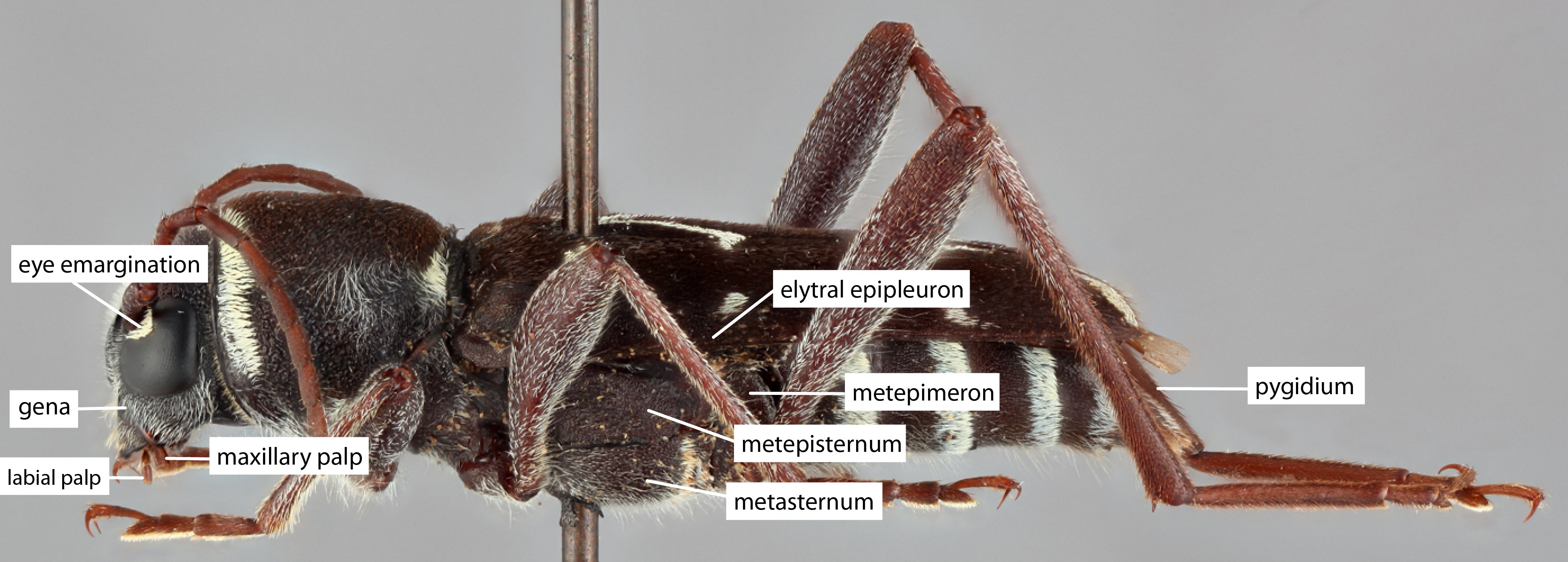 , eye ommatidial density fine.
, eye ommatidial density fine.
Antennae:antenna:
in larval and adult insects, paired segmented appendages, borne one on each side of the head, functioning as sense organs and bearing a large number of sensilla
antennal length reaches between basebase:
the part of any appendage or structure that is nearest the body
and end of elytraelytron:
the leathery forewing of beetles, serving as a covering for the hind wings, commonly meeting opposite elytron in a straight line down the middle of the dorsum in repose
, antennal flagellar segments elongateelongate:
much longer than wide
, scapescape:
the first proximal segment of the antenna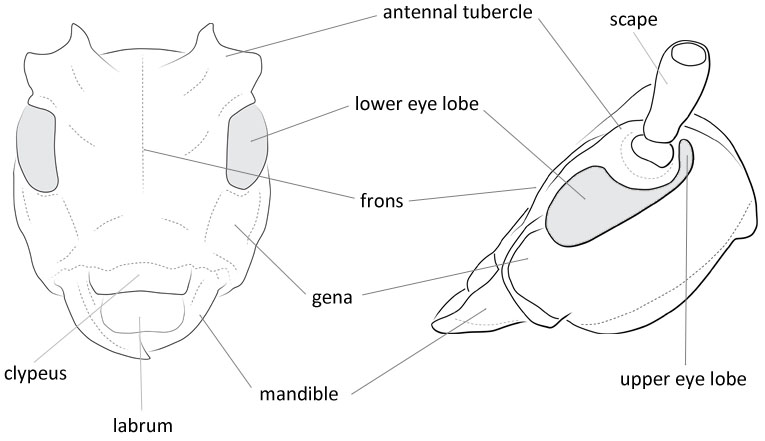 smooth/punctate at apexapex:
smooth/punctate at apexapex:
end of any structure distad to the base
, antennal scapescape:
the first proximal segment of the antenna ≥ segment 3.
≥ segment 3.
Pronotum:pronotum:
the upper and dorsal part of the prothorax
pronotumpronotum:
the upper and dorsal part of the prothorax
shape subquadratesubquadrate:
not quite a square
, pronotumpronotum:
the upper and dorsal part of the prothorax
lateral armature absent.
Prosternum: prosternal processprosternal process:
a posterior extension of the prosternum between the coxae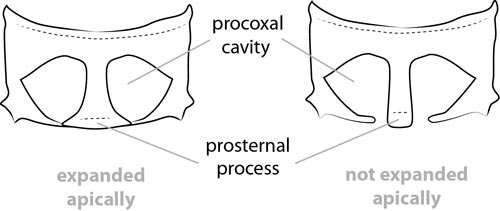 dilated or not at apexapex:
dilated or not at apexapex:
end of any structure distad to the base
, procoxal cavities open posteriorly.
Elytra:elytron:
the leathery forewing of beetles, serving as a covering for the hind wings, commonly meeting opposite elytron in a straight line down the middle of the dorsum in repose
elytral length reaching or close to end of abdomen, elytral apicesapex:
end of any structure distad to the base
emarginate, with tooth or spinespine:
a protuberance with an acute (sharp) distal end
, rarely rounded or truncatetruncate:
cut off squarely at the tip
, elytral color black, reddish or orange, elytral color pattern present or absent.
Legs: visible tarsomerestarsomere:
subdivision or article of the tarsus, usually numbering from two to five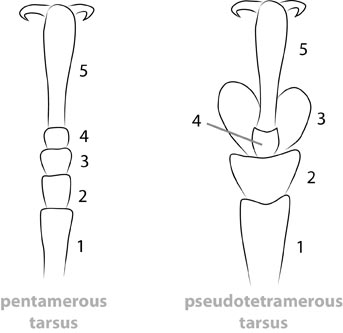 : 4, femora slender, protibial spursprotibial spur:
: 4, femora slender, protibial spursprotibial spur:
sclerotized spine(s) located at the distal tibia; can be single, double, or absent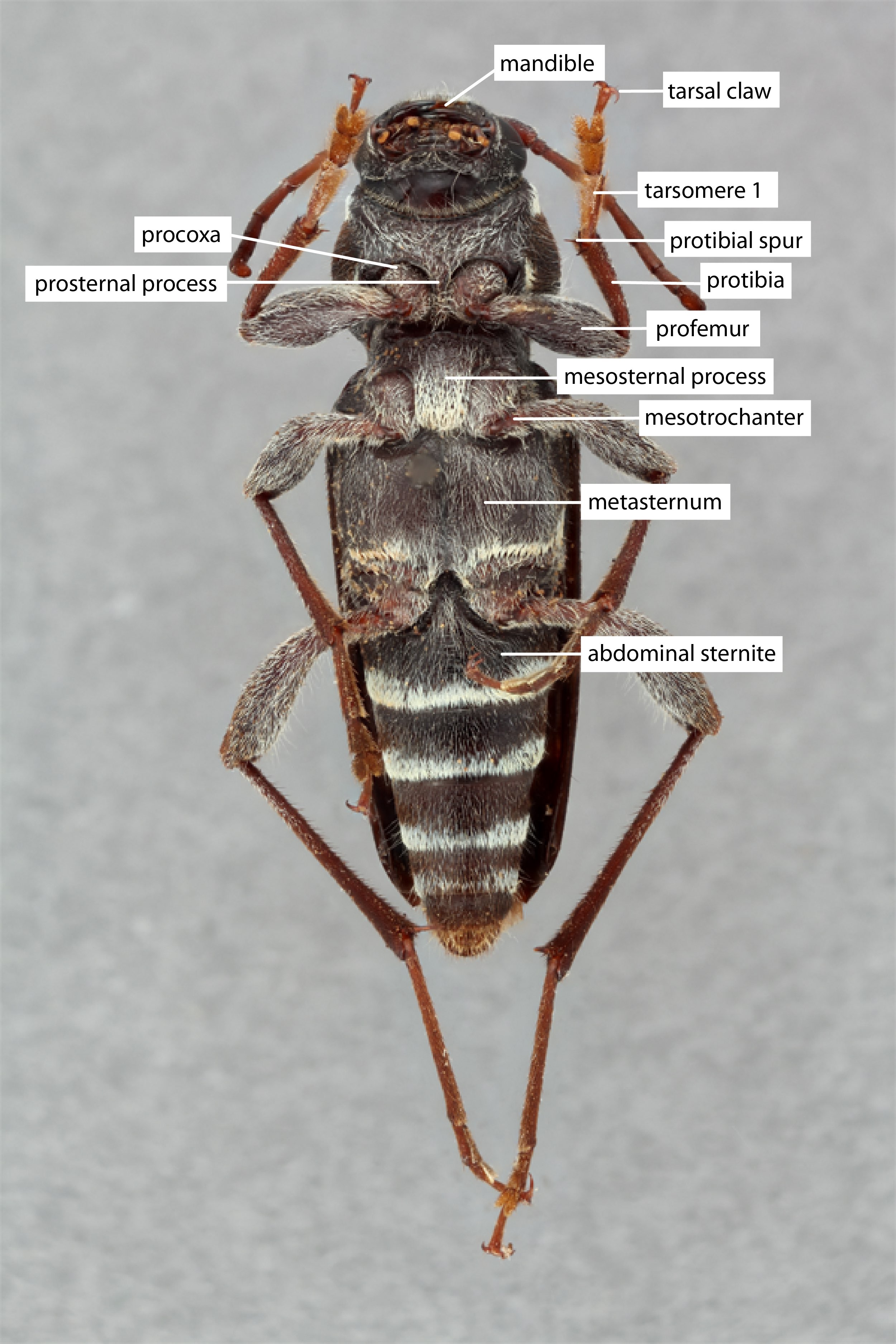 : 2, tarsal clawstarsal claw:
: 2, tarsal clawstarsal claw:
usually paired claws of the pretarsus, at the distal end of the leg simple.
simple.
Form moderately slender; integument distinctly punctatepunctate:
set with fine, impressed points or punctures appearing as pin-pricks
and pubescentpubescent:
downy; clothed with soft, short, fine, loosely set hair
. Head gradually narrowed behind the eyes, temples not convex, not abruptly narrowed to neck; face short, distance from a line connecting apicesapex:
end of any structure distad to the base
of antennal tubercles to anterior margin of labrumlabrum:
the upper lip, abutting the clypeus in front of the mouth shorter than width across outer margins of genaegena:
shorter than width across outer margins of genaegena:
the part of the cranium on each side below the eye ; eyes entire; antennal insertions below level of anterior margins of eyes; general area below eyes about half as long as length of eye: antennaeantenna:
; eyes entire; antennal insertions below level of anterior margins of eyes; general area below eyes about half as long as length of eye: antennaeantenna:
in larval and adult insects, paired segmented appendages, borne one on each side of the head, functioning as sense organs and bearing a large number of sensilla
barely reaching to or slightly surpassing middle of elytraelytron:
the leathery forewing of beetles, serving as a covering for the hind wings, commonly meeting opposite elytron in a straight line down the middle of the dorsum in repose
, third and fourth segments subequal or third a little longer, each shorter than scapescape:
the first proximal segment of the antenna . Pronotumpronotum:
. Pronotumpronotum:
the upper and dorsal part of the prothorax
about as wide as long, sides sinuate, apexapex:
end of any structure distad to the base
constricted, margin collared; disk more or less flattened behind and elevated or prolonged on each side into a tubercletubercle:
a small knoblike or rounded protuberance
; prosternum transversely impressed and striatestriate:
marked with parallel, fine, longitudinal, impressed lines or furrows
; mesosternummesosternum:
sternum of the mesothorax
broad in front with sides converging posteriorly. Elytraelytron:
the leathery forewing of beetles, serving as a covering for the hind wings, commonly meeting opposite elytron in a straight line down the middle of the dorsum in repose
distinctly more than twice as long as basal width. Legs slender; posterior tarsitarsus:
the leg segment distal to the apex of the tibia, bearing the pretarsus; consists of one to five tarsomeres (including pretarsus)
with first segment longer than two following together (Chemsak 2005Chemsak 2005:
Chemsak JA. 2005. Illustrated Revision of the Cerambycidae of North America. Volume II. Lepturinae. Wolfsgarden Press, Chino, CA: i–xv + 1–446, 27 pls.).
Euracmaeops, Dinoptera, Gnathacmaeops
The pronotumpronotum:
the upper and dorsal part of the prothorax
has a broad flange on the anterior margin in Acmaeops but not Dinoptera.
Nearctic
Pinaceae
2 species and another subspecies. The genera Euracmaeops, Dinoptera, and Gnathacmaeops seem to be in a complex with Acmaeops. They are all within 9% for the COI gene and are morphologically very similar. Dinoptera species are on broadleaf trees while the species stemming from Acmaeops sensu lato (Acmaeops, Euracmaeops, Gnathacmaeops) are conifer feeders.
N/A
Acmæops LeConte, 1850